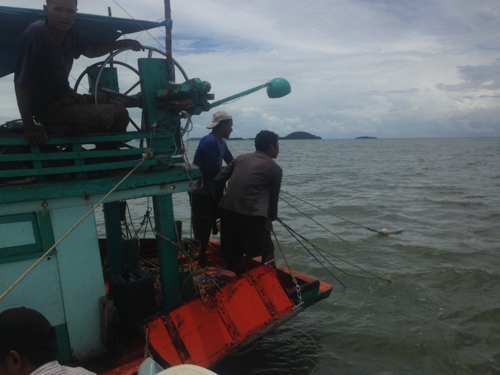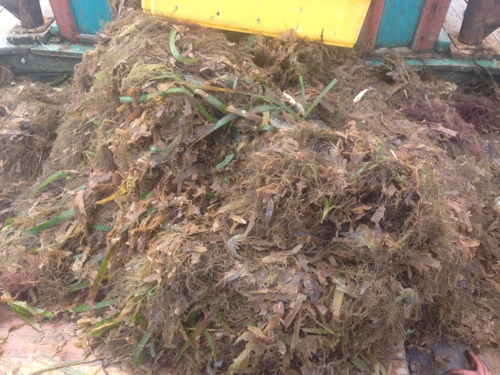Our third week started on our departure day to the island of Koh Seh. But first we needed to head to Kep market. Instead of hiring a tuk tuk we borrowed bicycles from the hostel. After sorting out some punctures we were off. Martin, AKA, the new Bradley Wiggins, stormed out into the lead closely followed by Belle, Tom and myself. About an hour later we arrived in Kep. Much to Tom’s delight there were mango smoothies for sale, which made the ride well worth it. On the way back the bells were discovered. Very soon after this the entirety of Kep knew Snoop Dog and Dr Dre’s “Still Dre” which rung out the whole way back. After hearing the excitement from the ride Katya and Ellen decided to make a trip as well (for the fact that we needed to withdraw money for the accommodation). I tagged along in hope of another entertaining ride, which in hindsight was a mistake as all three of us were caught in one of Cambodia’s notorious rainy season downpours. Nothing like I have ever experienced in England. As a result of not being able to see, Ellen made the decision to cycle as fast as possible. Why she did this, no one knows? The spray from the wheel just worsened and further blindness resulted. Nevertheless, we all made it back to hastily pack our bags ready for our departure. Paul Ferber, Founder of Marine Conservation Cambodia, kindly gave us a lift in his pickup truck or should I say on the back of his pickup truck to the pier where the boat was moored. After a quick game of street football we boarded the boat.
The journey was very choppy, with large waves crashing over the side of the boat and another downpour occurred. Naively only a few of us had a raincoat to hand, so for the second time that day I was wet, along with most of the team. However, non of us got nearly as wet as Nam, a Khmer local who fell in while showing off a little by climbing round the side of the boat, much to ever ones amusement. It was still a great introduction into island life and we were greeted with a spectacular sight when we arrived. We were to be staying on the island Koh Seh and the first thing you see as you arrive is the dense jungle. A dark green canopy dominates your view. As you near the island, a small pier comes into view, we didn’t know this at the time but it would be one of the best spots on the island for relaxing. As you moor up, in front of a small beach you can see one large building with a straw roof, but no sides, otherwise known as the main bungalow. This is the social hub for the island where all meals are consumed and many beers are purchased. As your eyes begin to adjust, dotted between trees and gardens, smaller versions of the main bungalow become apparent. These have walls constructed of bamboo, to provide some protection from the elements and were where we would be living.
We were greeted by a menagerie of children, dogs and chickens. After unloading the boat, Ellen, Katya and Belle were straight in the sea while Martin, Henry, Tom, Sean and Myself were introduced to Volleyball but the locals. Fair to say we were rubbish and after losing a soul crushing number of games we jumped off the pier to cool off. The water was amazingly clear and warm, even at dusk. And with the water just about deep enough to dive, we had a great time.
The next morning we took an initial tour of the island with our guides; Jasmine, aged eight, BooBoo, who was nine and Fern, six. We learnt of the layout of the island and although very small, had a variety of habitats as well as a number of remaining bunkers from the Kuhmer Rouge Regime. After lunch we started our first surveys. Initially we split the island into three groups with Tom and Martin on reptiles, Henry, Katya and Ellen on Avifauna and Sean, Belle and myself on Lepidoptera. Our methods were all very similar and involved setting up a transect line or establishing an area to wait and recording all the species we saw within a designated amount of time. We would then move the transect line to a different location within that section. All was well with Avifauna and Lepidoptera, however, after three days of searching, we decided it was not an efficient use of time or effort to continue this way with reptiles, having had no sightings. Therefore, Martin and Tom joined the other groups, but would still record any reptile sighting when they came across them.
Our surveys continued throughout the week on Koh Seh, with some 05:00 starts in order to observe a greater number and larger variety of birds and butterflies. One distinct early morning sighting was that of the Kingfisher, which made everyones day. Snorkelling, volleyball and cards were popular ways of enjoying our free time, while Sean “king of the snooze” got quite accustomed to his hammock. Slowly our volleyball game was improving and a game of Brits vs. Cambodians occurred, we lost again but was still great fun. At times, Martin did get a bit enthusiastic and started shouting chants rather loudly, which must have been heard by anyone within a five mile radius. After a relaxing weekend of films, cards and some of us returning to mainland, our first week on Koh Seh was concluded.
I think the best way to sum up this place is with a sign hanging up in the main bungalow that reads “Just another day in paradise”.
Words by Matt Holland


